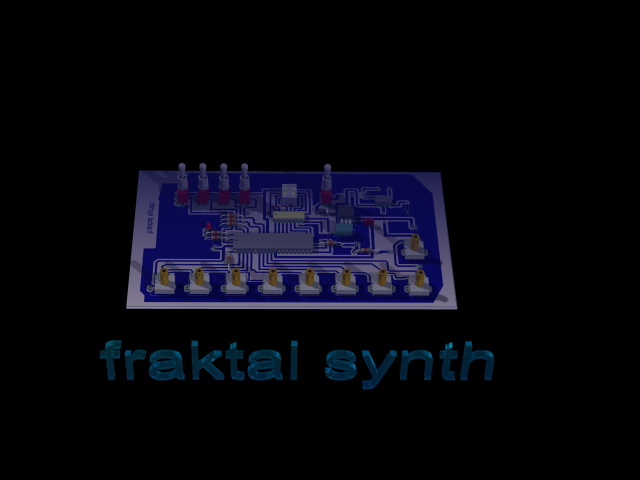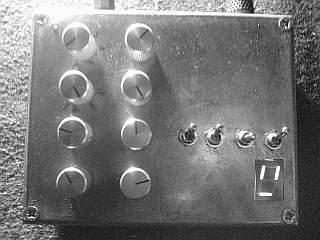
GIF image of Eagle 4.14 schematic by yerpa58
Schematic file from Eagle 4.14 by yerpa58
PC board layout file from Eagle 4.14 by yerpa58
What is it? The fraktal synth is an electronic musical instrument designed
by Eric Boger, who has kindly made the design files available to
anybody who is interested in this unique design. The circuit is very simple,
based on Microchip's PIC chip. Many sample sound files are
available along with Eric's original source code and schematics at:
http://www.gjcp.net/~catweazle/PICsynth/
The following text is copied from the
Electro-Music forum
. You will notice that many of the links are already broken, that is why I have copied
some of the text and files to my server. Eric's stuff is in
orange text. My stuff is the yerpa 58 stuff.
Enjoy!
catweazle
Joined: Feb 25, 2008
Posts: 15
Location: germany
Posted: Wed Apr 09, 2008 4:17 pm
Post subject: fraktal synth
Hello everyone!
I've developed that thing with the intention to have a versataile
simple lofi audio hardware to realize some unusual sounds.
Documentation:
Ok, sourcecode could have more comments Embarassed
ask if questions
Edit:
use this schematic if you build it
Hardware:
- a cheap (yes, samples) 8bit microcontroller to be real lofi Smile
- 8 analog inputs / pots for parameters (CV in 0..5Volt)
- 1 analog output (Pulse with modulation) / audio out
(output is not filtered very well, add additional Filter / EQ + FX)
however it really makes crazy sounds Wink
and I'm very interested of your experiences (pics/sounds) ...
gtz
Eric
I'm glad you got it working Ole.
Quote:
neighbor came downstairs to see if something was wrong with the washing machine
Very Happy
Connecting
a SPI EEPROM 25LCxx or MMC/SD card if a lot memory is needed.
2 analog input ports are free for use, too. one word: audio input...
One word (or more) about the programming language choosen
Why C ? - Assembly is much more efficent.
Posted: Sat Apr 12, 2008 3:53 pm Post subject:fraktal synth
yes, that would be cool if a little "open source community" evolves,
sharing patches/plugins (or whatever we call them)
The UART (serial port Rx/Tx, also usable for MIDI Wink
and SPI-/I2C-Bus pins are free for use.
I've choosen the LED display because of easy/cheapness and it needs very little performance to interface (compared to an LCD).
allways remember:
the PIC is no PC nor DSP, all should be kept as simple as possible.
- code is readable and can be understood a few years later
- structurized code (not "sphagetti code" with a lot of jumps and gotos)
- much more faster development (idea to algorithm)
- coding a PIC in assembly is not funny
- porting algorithms to other microcontrollers (code recycling)
if much more performance is needed better choose a faster controller
like ARM, Propeller, PIC32, DSP ... Nintendo GBA/DS, PSP, PocketPC ...
but inline assembly packed in a C function is a good idea to
gain maximum performance out of an time critical part of a
synth plugin.
in the moment the PIC is running with the internal oscillator (32MHz),
I had overclocked a PIC up to 100MHz (factor 2.5 , 40MHz is normal)
and it worked Cool
but this is not recommended because some of the internal periphericals (RAM...)
cannot operate at that clock rate, missfunctions occur ...
Maximum clockrate may vary from device, temperature, shielding...
but that can be very interessting thinking of circuitbending.
Errors can be very musical Wink

The original fraktal synth by Eric Boger (catweazle)
catweazleHere is the zipped file with Eric's original source code. There is also a jpg of Eric's original schematic.